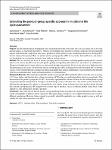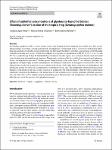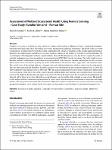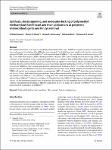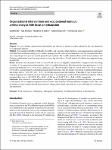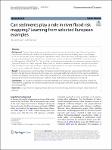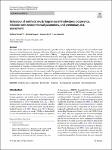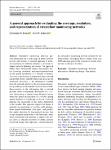Search
Author
- Osman, Ahmed I. (5)
- Chen, Zhonghao (2)
- Ricohermoso III, Emmanuel (2)
- Wang, Yongbin (2)
- next >
Subject
- LCA (6)
- ICP-MS (3)
- Artificial intelligence (2)
- CDW (2)
- next >
Date issued
Has File(s)
- true (220)
Search Results
Recent methodological developments have integrated nutritional aspects into life cycle assessment (LCA) by using nutrient indices as functional units (nFUs). Previous developments have focused on protein-rich foods, but environmental impacts and nutritional composition vary across products in other product groups, highlighting the need to develop nFUs also for other product groups. Here, we present product-group-specific nFUs for vegetables, fruit and berries, and sources of carbohydrates as an extension to our previous study on protein sources. |
In Colombia, glyphosate (GP) is used to control weeds, with Roundup Active® being the most widely used. This use has affected aquatic ecosystems, causing malformations in amphibians. The Savannah frog (D. molitor) is a tropical frog inhabiting the mountain of Colombia. In the present study, we determined the effect of sublethal concentrations of GP (Roundup Active®) on the skin of D. molitor. Twenty-four tadpoles were exposed to concentrations of GP (T1: 0, T2: 1.4, T3: 3.6, and T4: 5.6 a.e mg/L) during 31 days. In 10 individuals per treatment, two skin regions were evaluated: dorsal cranial and caudal ventral to determine histopathological alterations. Morphometric analysis of the layers of the skin was performed: epidermis, dermis, and hypodermis-muscular. T1 did not present histo... |
Complex ecosystems as wetlands are very sensitive to changes and disturbances. Human activities causing habitat fragmentation that alter landscapes affect the wetland ecosystems and negatively influence biodiversity. The health of the ecosystem is measured as a homeostasis between the system components and stability or resilience of the system against disturbance; therefore, any anthropogenic disturbances can cause dramatic changes in the balance of wetland ecosystem. Burullus, the second largest of the Egyptian northern coastal wetlands along the Mediterranean coast, has been recognized recently as critically endangered ecosystem according to an assessment using IUCN Red List of ecosystems. The study sought to assess Burullus wetland’s health based on multispectral indicators relat... |
The antibacterial activity of a variety of modified poly(methyl methacrylate) Schiff bases against common microbial infections and removal of methylene blue (MB) dye were screened. The Schiff bases were synthesized from the reaction of the modified (PMMA) with vanillin (PMMA)Van and cinnamaldehyde (PMMA)Cin. By using Fourier transformer infrared (FT-IR), X-ray diffraction analysis (XRD), thermogravimetric analysis (TGA), and scanning electron microscopy (SEM), the structures of the nanofibers of the synthesized Schiff bases were confirmed. The modified Kirky–Bauer method was used to screen the antibacterial activities of all the obtained materials against various bacterial species, including gram-positive bacterial (Bacillus subtilis (4k1p), Staphylococcus aureus), Gram-negative bac... |
To assess whether organizational interventions are effective to prevent or reduce exhaustion, the core dimension of occupational burnout. |
This article deals with the analysis of CO2 emissions in Latin America by using a long memory process based on fractional integration. Using data of CO2 emission and CO2 emissions per capita, for 32 Latin American and Caribbean countries, the results show significant differences according to the variable examined, the model used, and the country under examination. In particular, for the CO2 emissions, mean reversion is found in Belize and also under some circumstances in Antigua and Barbuda, Colombia, Dominica, Dominican Republic, Ecuador, Grenada, Honduras, Nicaragua, Panama, Peru, and Uruguay. Thus, shocks in these series have a transitory effect. |
Climate change and increasing anthropogenic pressure are two of the major drivers of increasing extreme events like droughts and floods. To deal with the increasing number of flooding events hitting Europe in the last few decades, around twenty years ago the European Commission started to develop ad-hoc legislation to reduce flood risk by mapping flood hazard and risk areas, such as the Directive 2007/60/EC on the Assessment and Management of Flood Risk. This Directive looks to identify regions where flood management strategies should be prioritized. Despite this holistic approach, flaws connected to the consideration of sediment transport and morphological changes in rivers exist, leading to potential underestimations of the impact of floods affecting active watercourses or areas s... |
The aims of this study were to investigate the presence, possible sources, and potential ecological risks of synthetic musk fragrances in freshwaters and sediments of the main tributaries of a deep subalpine lake in Northern Italy. The total musk concentrations ranged from few ng L−1 up to values > 500 ng L−1, depending on river characteristics: water flow and the presence of wastewater effluents proved to be the main factors affecting fragrance concentrations. The water flow may indeed dilute fragrance input mainly deriving from treated wastewaters. Good correlations (determination coefficients > 0.60) between synthetic fragrances concentrations and parameters related to anthropogenic impacts confirmed this hypothesis: synthetic fragrances were mainly detected in most polluted rive... |
Streamflow monitoring networks provide information for a wide range of public interests in river and streams. A general approach to evaluate monitoring for different interests is developed to support network planning and design. The approach defines three theoretically distinct information metrics (coverage, resolution, and representation) based on the spatial distribution of a variable of interest. Coverage is the fraction of information that a network can provide about a variable when some areas are not monitored. Resolution is the information available from the network relative to the maximum information possible given the number of sites in the network. Representation is the information that a network provides about a benchmark distribution of a variable. Information is defined ... |
Following the publication of the original article [1], a mistake was found in the temperature data for the three regions in Scotland. This error affected some results marginally, however the conclusions and key messages remain valid after the error was corrected. |

